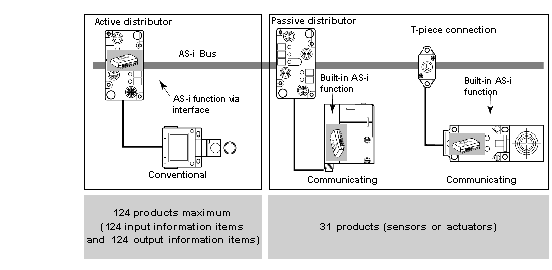The AS-i bus is a field bus (level 0) and can be used to connect sensors/actuators. This allows "Discrete" type information to be routed between a bus master and sensor/actuator slaves.
AS-i is composed of three main standard elements:
The main types of sensors/actuators
-
Communication sensors/actuators:
With a built-in AS-i function they link up directly to the AS-i bus via a passive distributor or a T-piece connection.
-
The traditional IP65 sensors/actuators:
They connect to the bus via an AS-i interface (active distributor or Telefast IP20 discrete input-output bus interface). These interfaces are used to connect conventional sensors and actuators to the AS-i bus and provide them with capacity for dialog on the bus.
Illustration:
The AS-i cable is a twin-wire link on which communications and power supply for the connected devises are transmitted.
The link does not need to be twisted.
The cross-section of wires can be from 2 x 0.75 mm2, 2 x 1.5 mm2 or 2 x 2.5 mm2, according to the current consumed by the devices.
Topology and Maximum Length of AS-i Bus
The topology of the AS-i bus is flexible. It is adapted to meet the userís needs (point to point, on line, tree structure etc.).
In every case, the total length of all the branches of the bus must not exceed 100 meters without a relay.
This is the cycle time between slave(s) and the 140†EIA†921†00 module.
The AS-i system always transmits information, which is the same length to each slave on the bus. The AS-i cycle time depends on the number of slaves connected to the bus.
In the presence of 31 functioning slaves, this time period will be a maximum of 5 ms.
Reliable operation is ensured by the transmission process used (Manchester current and coding modulation). The master monitors the line supply voltage and the data sent. It detects transmission errors as well as slave failures, and sends the information to the PLC.
Exchanging or connecting a new slave during operation does not disturb communications between the master and the other slaves.
